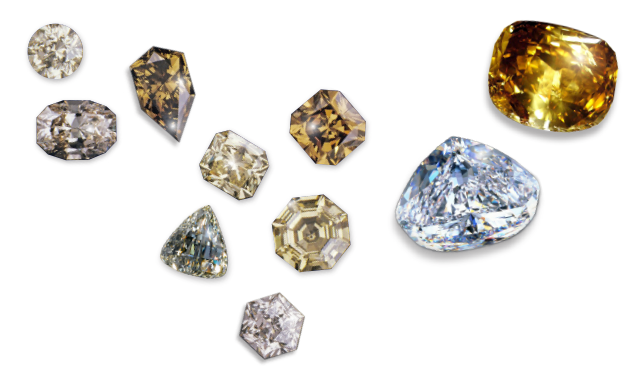Born in Tel Aviv in 1939 to a family of diamond cutters – including his uncle Marcel, credited as the inventor of the round brilliant cut – Sir Gabi was trained by his father Jean and at the age of 16, was tasked with polishing a 100-carat emerald-cut diamond.
In 1975, he began working with De Beers for whom he developed the Flower Cuts collection.
In the 1980s, Sir Gabi and his son Jean Paul – also a master cutter – were secretly commissioned to cut the Unnamed Brown, a 755.5-carat brown stone unearthed at the Premier Mine in South Africa.
An underground workshop, free of vibration, was constructed to ensure no damage came to the stone as it was meticulously whittled into a 545.65-carat Golden Jubilee Diamond, which remains the largest cut and faceted diamond in the world – outweighing even the Cullinan I, which had held the title since 1908.
The stone was completed in 1990 and later became part of the Thai Crown Jewels.
When De Beers unearthed a 599-carat rough in South Africa in 1986, Sir Gabi was also selected to lead an expert team to transform it into what would become the world’s largest D Flawless stone, The Centenary Diamond.
The rough was so fragile and so valuable, that no heat or laser could be used in the initial cutting process.
Years later, Sir Gabi recalled, “I will never forget how I worked on the Centenary for 154 working days – an entire working year – carving and carving away with my bare hands. I removed more than 50 carats before we started polishing.”
The finished diamond – weighing 273.85 carats with a modified heart shape – was completed in February 1991 and unveiled in May that year, insured for more than $US100 million.
Drawing from techniques developed during the polishing of the Centenary and the Golden Jubilee Diamonds and from the De Beers Flower Cuts, Sir Gabi created the Gabrielle cut, known as the first ‘triple brilliant’ and which was later sold throughout Europe, Asia, and the US.
Founding his namesake company Gabi S Tolkowksy & Sons in Antwerp, Belgium, in 1995, he later created the Sea Shells Cuts collection.
In 2003, he was presented with the title Chevalier de L'Ordre du Roi Leopold II (Knight of the Order of King Leopold II) for his services to the diamond industry.
Here, Sir Gabi discusses his experiences and legacy as the world’s foremost master diamond cutter.
What was it like to grow up in a family with such a strong connection to diamonds and diamond cutting?
GT: I was the sixth generation, learning cutting and polishing from my father Jean Tolkowsky, who cut and polished as a young boy of 10 years old together with his cousin Marcel Tolkowsky, learning from their fathers and uncles. So it was natural to attract my own wish to become a diamond cleaver, cutter and polisher.
What are your fondest memories of your career in the diamond industry?
GT: Having participated in the planning and creations of the Flower Cuts, the Sea Shells Cuts, and others, and the Centenary Diamond and Golden Jubilee.
You were responsible for cutting the largest faceted diamond in history, the Golden Jubilee. How did this come about and what did this process involve?
GT: Without having a team of 15 expert scientists, technicians, security guards and master diamond cutters that communicated daily with me during three long years, I would have never been able to achieve the uniqueness of such a creation.
Together we realized that every single diamond is effectively an individual that will attract every human’s senses; each one of them is a unique beauty.
As it is said, “Beauty is altogether in the eye of the beholder.” This, without any doubt, was and still is the basic reason for humans to continue to manufacture and deal with diamonds.
How has diamond cutting evolved over time, both as an art and commercially?
GT: No matter what the position is of humans that are involved in transforming
a rough diamond into a polished one, they are marking art that allows them also to be commercially busy if they wish.
They are all part of a unique artistic movement.
Where is the centre of innovation, today, in terms of diamond cutting?
GT: Without any doubt, due to the evolutionary period that we are witnessing, centres of innovation do exist and will continue to develop in various parts of the world.
This is because approaching beauty is a normal human evolution; it allows people – men and women – to express themselves according to their cultural environment.
As a matter of fact, beauty is not only an artistic reaction, but also a way to wish, hope and dream – beauty is a haven of peace!
Without any doubt, it is my wish to continue the legacy of the importance of beauty by my children and grandchildren
 |
| Left to Right: A selection of diamond cuts developed by Sir Gabriel Tolkowsky from the Flower Cuts and Sea Shell Cuts collections; Centenary Diamond, 273.85 carats; Golden Jubilee Diamond, 545.65 carats |
Read eMag